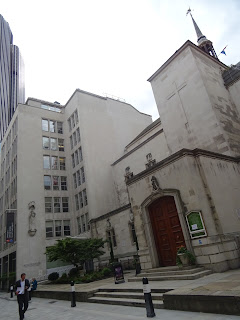The present Dutch Church was built between 1950 and 1954, and contains paintings, memorial plaques, stained-glass windows and tapestries symbolising the key elements of its history: the Christian religion and the Reformation, the history of the Dutch nation, and the relationship with the House of Orange.
External stonework, including relief crests above each window, and above the entrance - the latter commemorating the beheading of the Duke of Arnold in C14 (he was buried in the old church) - by John Skeaping. Skeaping was a 'sculptor, mainly of animals.' 'Skeaping studied at Goldsmith's College, London, and later at the Royal Academy. In 1924 he won the British Prix de Rome and its scholarship to the British School at Rome. Skeaping was the first husband of the sculptor Barbara Hepworth, with whom he exhibited during the 1920s. He was a member of the London Group, and later worked for a period in Mexico. He was elected to the Royal Academy in 1960.'
The glass in the aisle is by W Wilson, 1954-8, and includes a commemorative memorial to the church's friendly associations with the Church of England and the Church of Scotland. 'To the north of the sanctuary is glass donated by the Worshipful Company of Carpenters, connected to the Church since 1558. Opposite is glass donated by the Corporation of the City of London. Memorial window to Queen Wilhelmina, of 1962 by Rev. Kok. Three western windows by Max Nauta commemorate the history of the church and the sixteen English towns who permitted the Dutch community to worship in C16.'
'On the main stair is Max Nauta’s (1896-1957) stained glass commemoration of the Glorious Revolution of 1689, when the Catholic James II of England was defeated and succeeded by his Protestant daughter, Mary II, and her Dutch husband and cousin, William III.
Both are depicted in sparkling stained glass that has a jewel-like, three dimensional quality, owing to Nauta’s use of small pieces of differently coloured glass as a substrate before painting. The huge west window is Nauta’s work also, with vivid royal portraiture, saints and heraldry.' Dutch artist Max Nauta worked on two sets of windows in the UK, the Austin Friars Church and St Andrews, Roxbourne, Harrow.
'The first commission Nauta received as a stained-glass artist was from the elders and deacons of the Dutch Reformed Church at Woerden, to design a memerial window to commemorate Johannes Pistorius (1925). This window - which to this day is a great source of pride to the members of the congregation, was produced by the Bogtman Studio, Haarlem, under Nauta's supervision and with his personal cooperation. All his later windows were produced - also under the artist's supervision - in the studios of either Messrs. Schrier or Messrs. De Ru (both also at Haarlem). The treatment with “grissaille” of the most important details, as well as the sorting and arranging of the pieces of stained glass are invariably the work of the artist's own hands. Many other commissions followed after this: St. Jacobs Church at The Hague; the Great Church at Delft; Dutch Ford Automobile Works; Shell.'
'On the south wall is a large tapestry depicting the ‘Tree of Life’ by Dutch artist Hans van Norden (b. 1915). It is a remarkable work, recombining traditional Biblical imagery with modernist/ classicising forms in pastel, not pale, colours.' Van Norden studied at the State Academy of Fine Arts in Amsterdam under Heinrich Campendonk and John Jurres. Norden was a versatile artist (graphic artist, watercolourist, draftsman, glass painting, wall painting, monumental artist, painter, maker of mosaic, textile artist). He was a lecturer at the Academy of Drawing Teachers Tilburg. In 1946-1947 he was co-founder of the painters, the Realists' as the alternative to the famous Cobra movement and other "abstract'-working artists."'
'On the south wall is a large tapestry depicting the ‘Tree of Life’ by Dutch artist Hans van Norden (b. 1915). It is a remarkable work, recombining traditional Biblical imagery with modernist/ classicising forms in pastel, not pale, colours.' Van Norden studied at the State Academy of Fine Arts in Amsterdam under Heinrich Campendonk and John Jurres. Norden was a versatile artist (graphic artist, watercolourist, draftsman, glass painting, wall painting, monumental artist, painter, maker of mosaic, textile artist). He was a lecturer at the Academy of Drawing Teachers Tilburg. In 1946-1947 he was co-founder of the painters, the Realists' as the alternative to the famous Cobra movement and other "abstract'-working artists."'
-----------------------------------------------------------------------------------------------
Brian Kennedy - A Better Man.








No comments:
Post a Comment